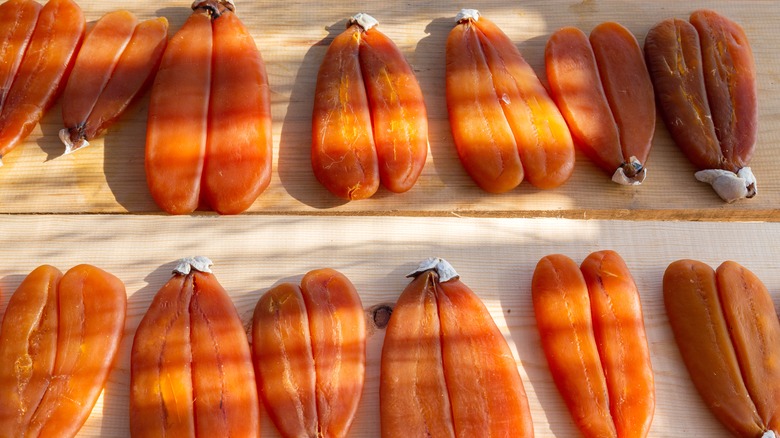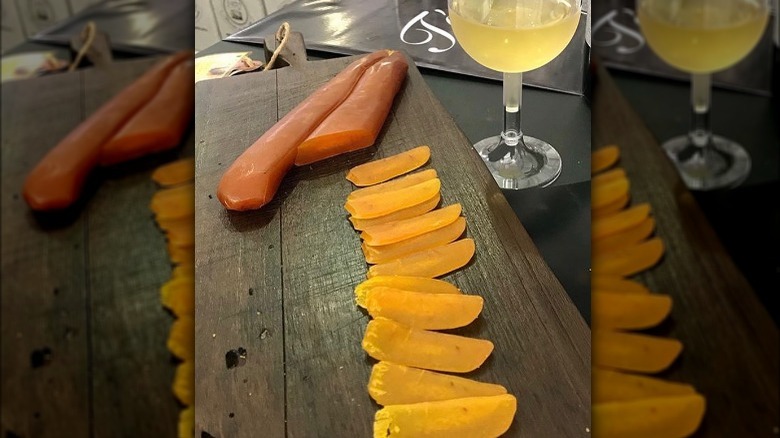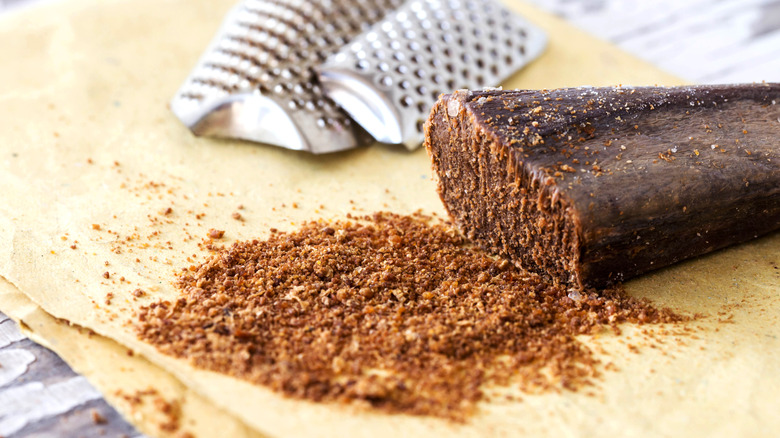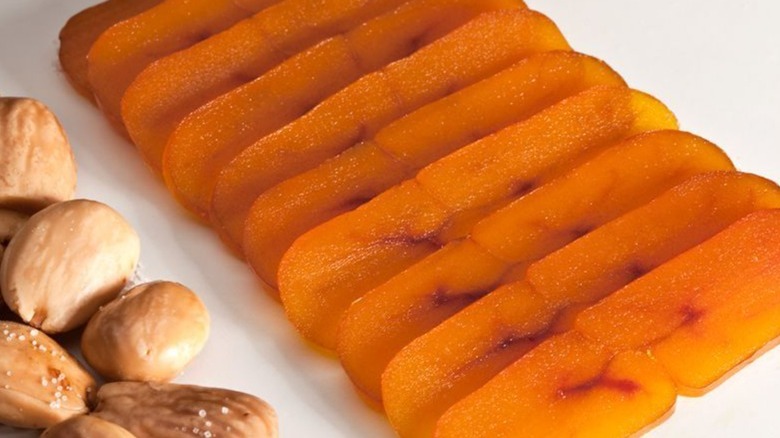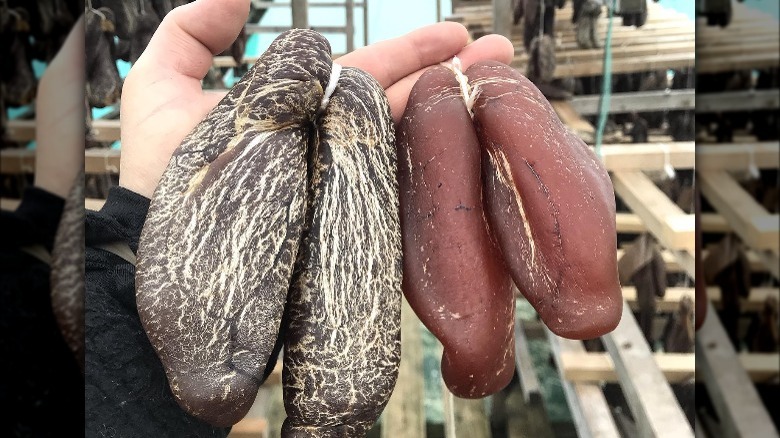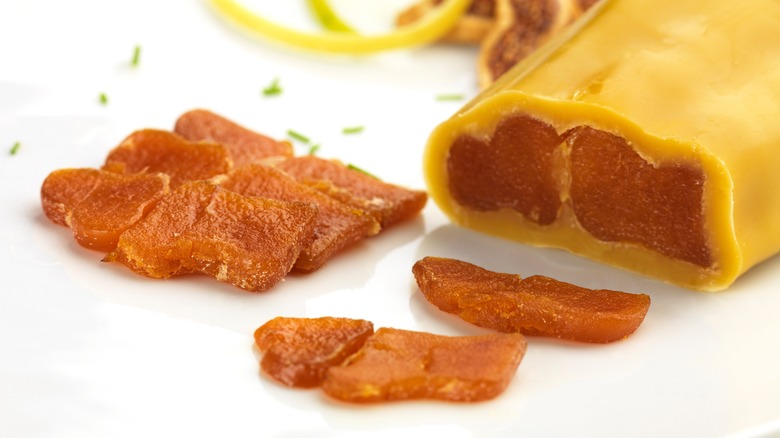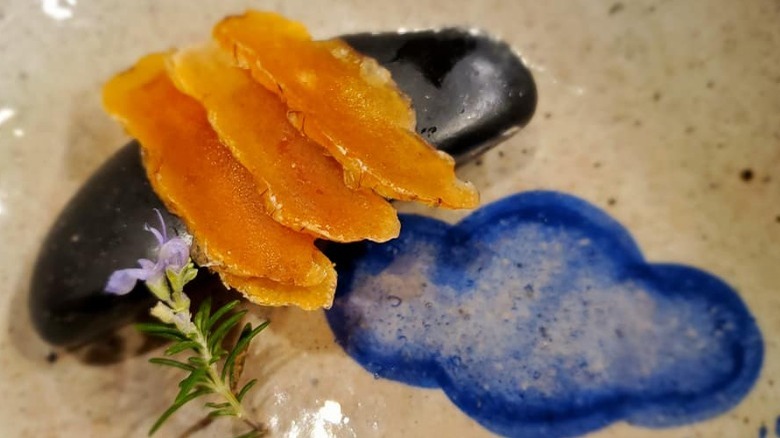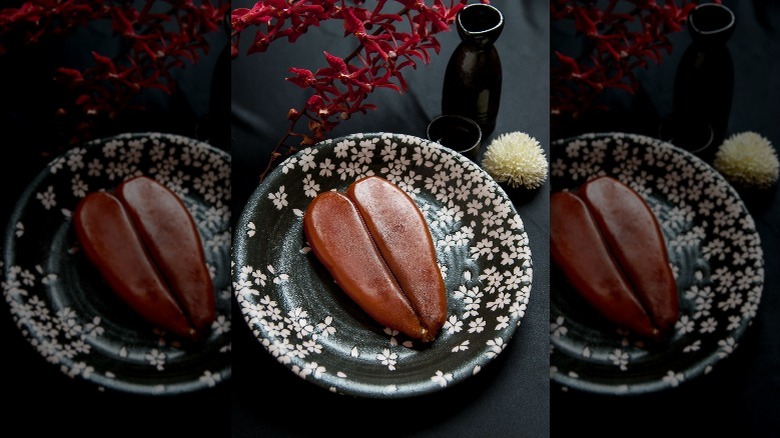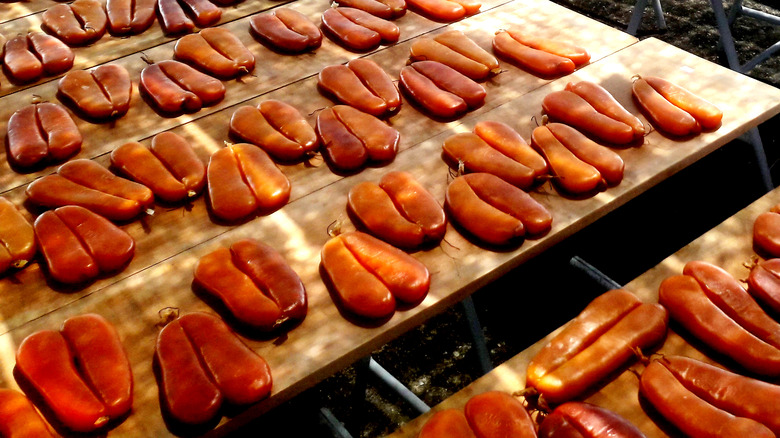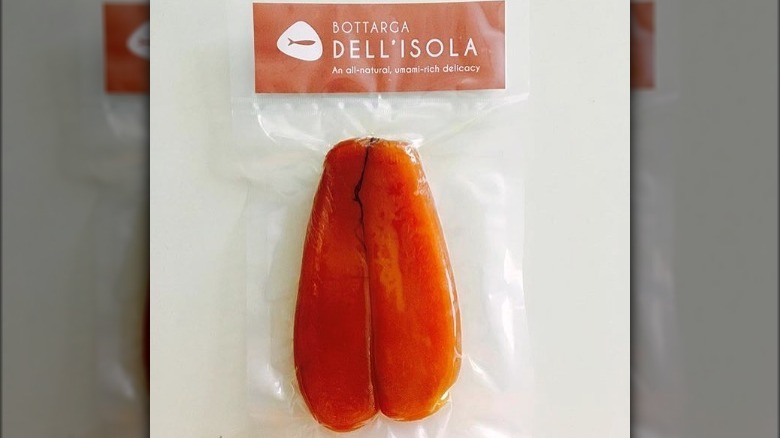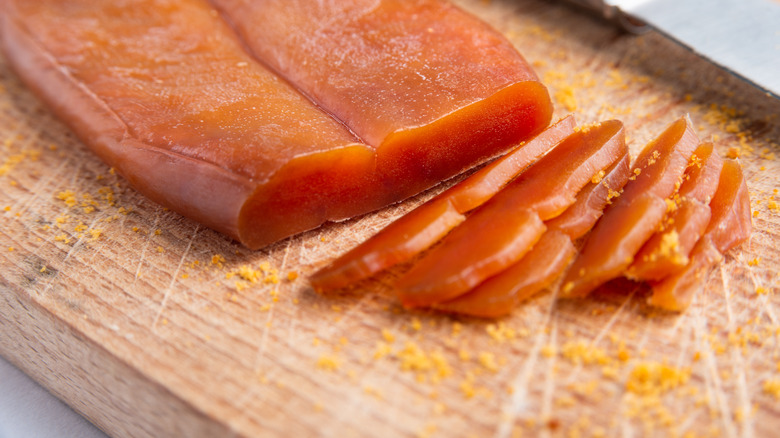9 Types Of Bottarga, Explained
Visitors to coastal areas in parts of Southern Europe and Northeast Asia aren't likely to miss the sight of brightly colored, heart-shaped patties sitting out in the sun to dry. The patties may have different names whether it's called eoran in Korea, karasumi in Japan, or bottarga in Italy, but these alluring delicacies all offer the briny taste of the ocean, per MasterClass.
The origins of this seaside delicacy are under some dispute. Serious Eats says that on the one hand, the method of preserving sacks of fish roe can be found recorded in Egyptian wall art which dates back to the 10th century B.C.E., while historian Andrew Dalby says bottarga was known to residents of ancient Greece and Byzantium as far back as 600 B.C.E. Dalby mentions this in his book "Tastes of Byzantium: The Cuisine of a Legendary Empire," where he points out that not only did the Byzantines enjoy classical Greek seafood, they also "appreciated salted greymullet [sic] roe." The name "bottarga" itself comes from the Arabic word "battarikh," which is what it was once called, per Great Italian Chefs.
Bottarga is also known as "poor man's caviar" for a reason. The delicacy was actually born out of the ancient fishermen's need to keep from wasting any part of the fish that they had caught, which is likely why no one species of fish — even to this day — is used to make this delicacy.
Sardinian Bottarga aka Sardinian gold
Great Italian Chefs says each region makes bottarga in a slightly different way, and with different types of fish.
In Sardinia, Italy, gray mullet are caught in September, when the fish is at its plumpest, per The Guardian. Its egg sacs are harvested, covered in salt, and then pressed flat before the heart-shaped patties are left to air dry in the sunshine to become what is known as "Sardinian gold." This type of bottarga is said to have a sweet-but-savory flavor, as well as a scent reminiscent of almonds.
This amber-colored bottarga is also known as "Sardinian caviar," and it is usually shaved over pasta. But The Guardian points out that the amber-colored treat can also be sliced thin and served with a touch of olive oil as a snack.
Bottarga di tonno or Sicilian bottarga
In Sicily, tuna roe is extracted from bluefin tuna, which can leave you with a large gray brick, per MasterClass. This tuna bottarga or bottarga di tonno can have a stronger and more fishy flavor than mullet roe bottarga, per Gustiamo. According to Great Italian Chefs, this particular variety takes about thirty days to make and involves repeated washes and salt baths to get rid of all traces of blood.
Because the presses that are used to squeeze the bottarga are heavy, the product ends up being more solid. This type of bottarga delivers an umami flavor, whether it is served in thin slices, or shaved on top of pasta, mashed potatoes, risotto, scrambled eggs, or pizza.
Unfortunately, because the world's tuna stocks have been greatly depleted, Gustiamo says bottarga di tonno made with Mediterranean bluefin tuna has become more difficult to find.
Hueva de Muhol or Spanish bottarga
Bottarga is made in the south of Spain, located across the Mediterranean from Italy. There, Basco says Hueva de Muhol is made with gray mullet roe, which delivers a nutty and salty taste.
The Spanish Store says salt is first added to mullet roe before it is massaged so any air trapped inside the egg sacs is removed. The roe sacks are then pressed and dried, with the resulting bottarga imparting the taste and texture of hard cheese. The Spanish Store also compares the flavor to caviar.
Like other bottarga, Hueva de Muhol is either sliced thin or shaved on top of salads, pastas, or eggs.
Norwegian (cod) bottarga
Norwegian bottarga doesn't have the same long, storied history as some of the types of bottarga that can be found around the Mediterranean. The idea for Norwegian bottarga came from Jonas Juselius, who created the product by experimenting on roe taken from skrei or Norwegian Atlantic cod in 2007, per Bottarga Borealis.
Caviar Star says cod bottarga has a milder flavor than its mullet and tuna namesakes, and that its fat content, which comes in at 2.6%, is also lower, with mullet roe fat coming at 25%. Caviar Star further explains that the cod roe is salted and kept out in the cold for 10-15 weeks to dry out.
Avgotaracho or Greek bottarga
Gray mullet roe is also used to make Greek-style bottarga, also known as avgotaracho, per Greece Is. This regional variety of bottarga is made in the summertime when the egg sacs of the flathead gray mullet are harvested. After the sacs are carefully removed, they are washed and placed in salt for between 2-3 hours, before they are massaged to ensure the salt is absorbed.
Once that is done, the online publication explains that the mullet roe is left to dry out before its sacs are shaped, and returned to age and dry until they fully dehydrate. They are then covered in beeswax to ensure that their flavor is preserved.
Eoran or Korean bottarga
Like all other types of bottarga found around the world, Korean bottarga, or eoran, involves salting roe sacs before drying them out in the sun, but per the Encyclopedia of Korean Culture, this particular variety uses roe harvested from minnows as well as mullet. Serious Eats explains that eoran can be made by curing the roe with soy sauce instead of salt, and a touch of sesame oil is added during the drying process.
Korean food lovers may also speak of myeongnan, which is made with pollock, per Maangchi. It's different than other varieties of bottarga because it is seeped in a mixture of hot pepper flakes or gochugaru, mirin, garlic, and ginger for three weeks to create a fermented delicacy that can be cooked in a stew or served as a side dish with rice and soup.
Karasumi or Japanese bottarga
Bottarga reached Japan by way of the Silk Road in 1650, and the site Karasumi – which has the same name as the treat — says the dried fish roe delicacy was named after a Chinese emperor.
Most bottarga — or karasumi — is made in the coastal prefecture of Nagasaki. When it was first made, fishermen used mackerel but switched to mullet over time because it was better received. Japanese bottarga became such a hit that what was known as poor man's caviar in Europe was savored in the Japanese imperial court.
Because mullet roe is very fatty, Karasumi says it takes a while to produce Japanese bottarga. The manufacturer says only sacs that measure between 27 to 30 inches are selected before they are seasoned with Nagasaki salt. The roe sacs are then pressed and exposed to temperatures between 41 to 86 degrees Fahrenheit for about 40 days before it is ready.
Taiwanese bottarga
Taiwanese bottarga, also known as wuyuzi, has been around for three centuries, and at one point it was even used as currency, per Gold Thread. It was also seasonal, and could only be made in December and January when currents brought the spawning fish to coastal areas. Today, the delicacy is available year-round.
Wuyuzi is different from western bottarga in texture; Gold Thread says the Taiwanese delicacy cannot be grated because its texture resembles a creamy fudge more than it does a semi-hard cheese. As a result, the treat is sliced and served as a dish on its own, and not grated over warm dishes.
American bottarga
Closer to home, bottarga can be found on the coasts of the United States too. The Caviar Farm says North Carolina's jumpin' mullet is salted and cured to make the state's own version of bottarga, which yields a texture similar to that of hard Parmesan or Romano cheese, so it is either served sliced or grated over certain dishes. This type of bottarga is yellowish and appears lighter than the bright-orange-hued bottarga from the Mediterranean.
Then there is Bottarga Dell'Isola, which makes its own bottarga with roe sacks of gray mullet harvested from the Gulf of Mexico. Like other bottarga, it can be sliced and consumed, or shaved and enjoyed in a variety of dishes.
How bottarga is enjoyed
Depending on where you acquire bottarga, you'll probably find a fine cover around it. That, per Serious Eats, is the pellicle, which needs to be removed before bottarga can be grated and served over mashed potatoes or broiled vegetables. It can also be served over pasta and risotto dishes, over scrambled eggs, or even on top of a piece of buttered toast, per MasterClass.
Bottarga can also be used to make fried rice, or sliced and served with fruit like pears and apples, per Gold Thread. If you want to enjoy it on its own, you might want it sliced thin and served with lemon, or in a sandwich with olive oil or butter. You may be tempted to incorporate it into dishes, but cooking bottarga is not recommended, per Serious Eats. Its flavor is so delicate that it would be a waste to warm it up. The site also advises against buying grated bottarga, since it is best enjoyed when it is fresh off the patty.
That being said, bottarga can be kept for a few months, as long as it is tightly wrapped and refrigerated, so give one of the nine varieties of this umami-packed ingredient a try!
